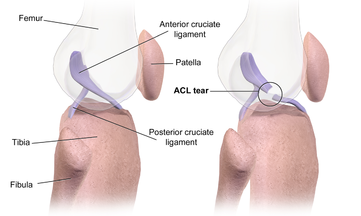Lever Sign Test
Original Editor - User Name
Top Contributors - Shwe Shwe U Marma and Kim Jackson
Purpose[edit | edit source]
Lever sign test, also known as Lelli’s test, is a test used to diagnose anterior cruciate ligament (ACL) rupture.[1]
Technique[edit | edit source]
Patient lies supine with fully extended both legs. One fist of clinician is placed under the proximal third of the calf. Then, with the other hand a downward force is applied over distal third of the patient’s quadriceps.[2]
Interpretation[edit | edit source]
Negative test: When the ACL is intact the downward force applied over the quadriceps will cause the heel to rise.
Positive test: With damaged ACL the downward force will cause anterior translation of tibia in relation to the femoral condyle. So, in this case heel will not rise.[2]
Evidence[edit | edit source]
Preliminary results suggest almost 100% sensitivity and specificity of Lelli’s test.[1]However, Jurbo et al (2007) found its sensitivity to be 63% and specificity to be 90%.[3]
References[edit | edit source]
- ↑ 1.0 1.1 Lelli A, Di Turi RP, Spenciner DB, Dòmini M. The “Lever Sign”: a new clinical test for the diagnosis of anterior cruciate ligament rupture. Knee Surgery, Sports Traumatology, Arthroscopy. 2016 Sep 1;24(9):2794-7.
- ↑ 2.0 2.1 Deveci A, Cankaya D, Yilmaz S, Özdemir G, Arslantaş E, Bozkurt M. The arthroscopical and radiological corelation of lever sign test for the diagnosis of anterior cruciate ligament rupture. Springerplus. 2015 Dec 1;4(1):830.
- ↑ Jarbo KA, Hartigan DE, Scott KL, Patel KA, Chhabra A. Accuracy of the lever sign test in the diagnosis of anterior cruciate ligament injuries. Orthopaedic Journal of Sports Medicine. 2017 Oct 9;5(10):2325967117729809.
- ↑ Jessica Keller. Positive Lelli's test! Available from: https://www.youtube.com/watch?v=44W5MER9IAA [last accessed 28 December 2020]







